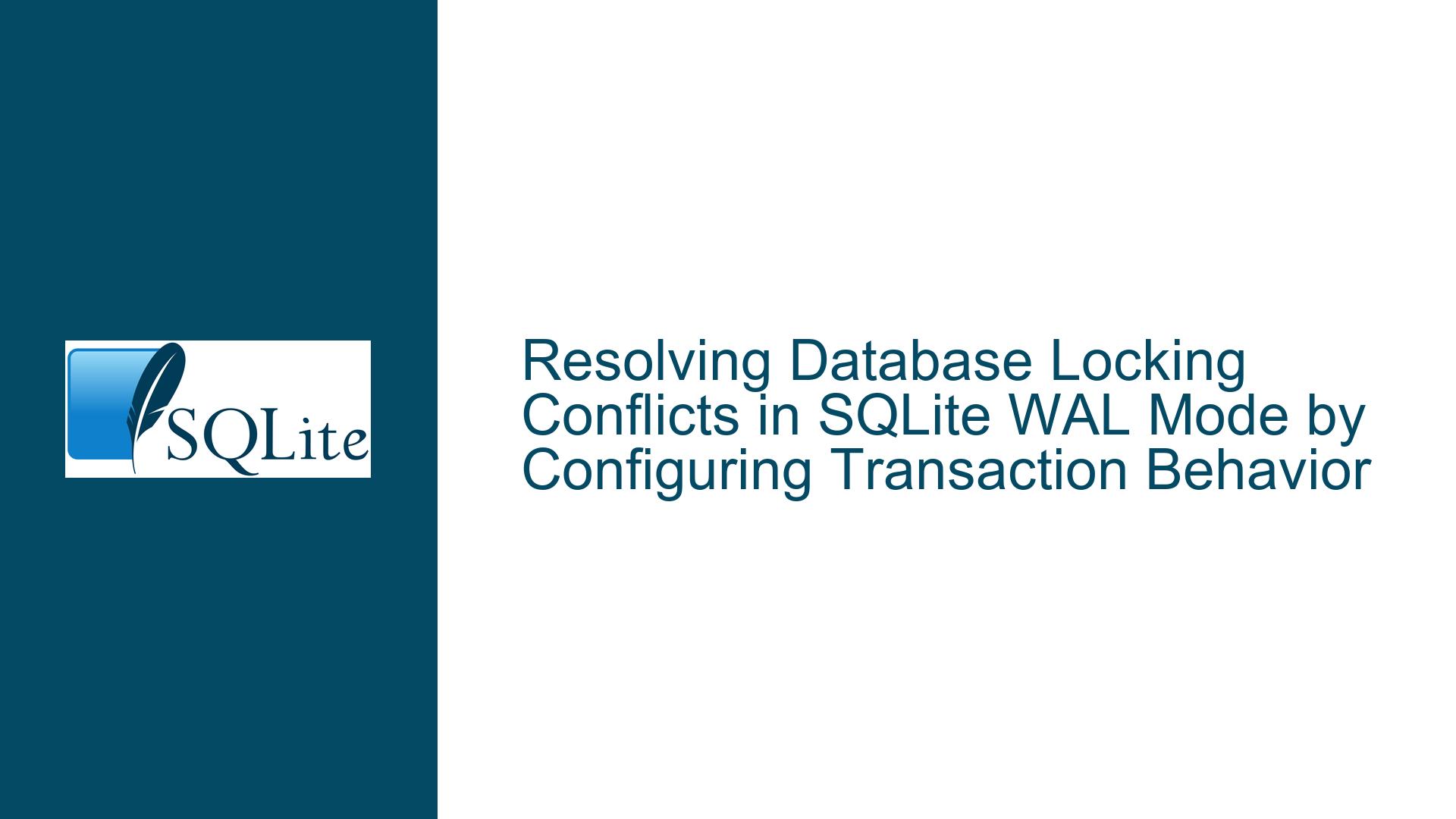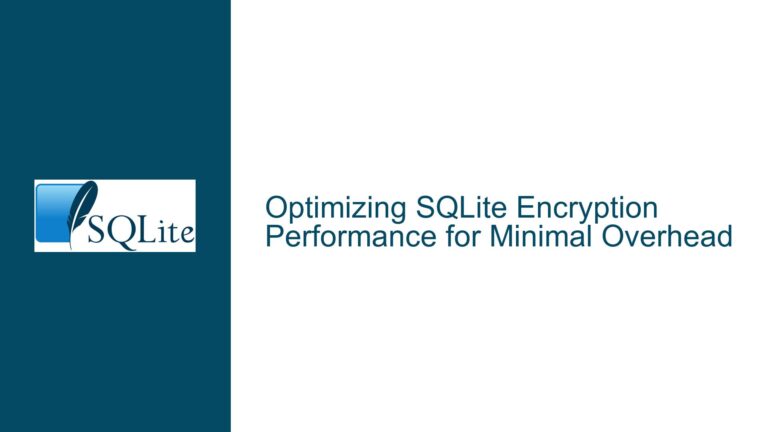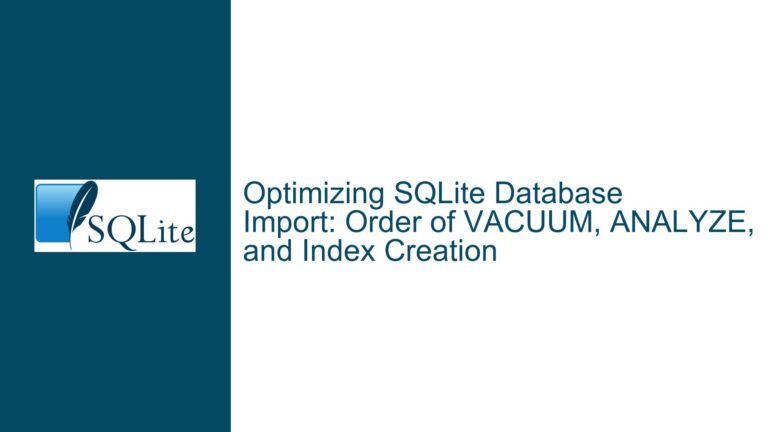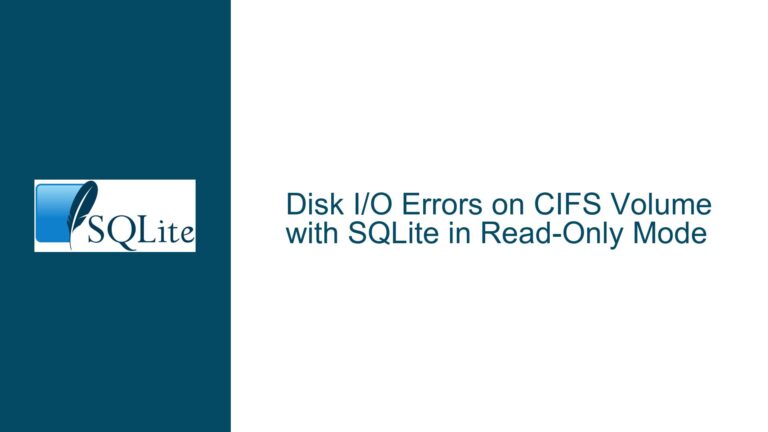Resolving Database Locking Conflicts in SQLite WAL Mode by Configuring Transaction Behavior
Understanding Transaction Modes and Lock Contention in SQLite WAL Environments
SQLite’s Write-Ahead Logging (WAL) mode significantly improves concurrency by allowing simultaneous reads and writes. However, applications leveraging WAL often encounter unexpected database locked errors when using deferred transactions. This occurs because deferred transactions start in read mode and attempt to escalate to write mode only when a write operation occurs. If another connection holds a read lock during this escalation attempt, the transaction cannot proceed, triggering locking conflicts. These errors are particularly problematic in middleware or web frameworks where transactions are automatically generated without explicit control over their initiation mode. Developers working with such systems may observe frequent locking issues despite WAL’s concurrency advantages, leading to instability in client-facing applications.
The root of the problem lies in the default DEFERRED transaction mode, which defers lock acquisition until the first write operation. While this design minimizes contention in read-heavy workloads, it creates a risk of lock conflicts when transactions frequently transition from read to write. Middleware layers that abstract database operations exacerbate this issue by generating transactions without specifying a mode, assuming the default behavior. For example, web frameworks that auto-wrap data modification operations in transactions without explicit BEGIN IMMEDIATE directives leave developers vulnerable to unpredictable locking errors. The absence of a connection-level setting to override the default transaction mode forces workarounds like retroactively modifying transaction statements, which introduces fragility and maintenance overhead.
A deeper analysis reveals that SQLite’s locking mechanism operates at the connection level. When a deferred transaction initiates a write, it must obtain a RESERVED lock. If another connection holds a SHARED lock (from a concurrent read), the escalation fails, resulting in a SQLITE_BUSY error. In WAL mode, this behavior persists despite its improved concurrency, as WAL primarily optimizes read/write parallelism rather than write/write conflicts. Applications with write-intensive workloads or mixed read-write transactions are disproportionately affected, as deferred transactions repeatedly clash during lock escalation. The challenge is compounded when client code cannot be modified to enforce transaction modes, leaving middleware layers to guess or intercept transaction initiation—a process prone to errors and inefficiency.
Causes of Lock Escalation Failures and Concurrency Degradation
1. Implicit Use of Deferred Transactions in Write-Heavy Workloads
Deferred transactions are optimal for read-only operations or scenarios where writes are infrequent and non-concurrent. However, many applications—particularly those using Object-Relational Mappers (ORMs) or web frameworks—implicitly initiate deferred transactions for write operations. For example, a framework might auto-wrap a series of database operations in a transaction without specifying IMMEDIATE, assuming the default behavior. When these transactions frequently perform writes, the deferred mode forces lock escalation attempts that collide with concurrent reads or writes. This mismatch between transaction intent and initialization mode creates avoidable contention.
2. Middleware or Framework Limitations in Transaction Control
Middleware layers that abstract SQL generation often lack mechanisms to specify transaction modes. A web framework might automatically start a transaction when a request begins and commit it after the response, without allowing developers to declare whether the transaction should be deferred, immediate, or exclusive. This forces developers to either accept the default deferred mode (risking locks) or resort to invasive code modifications to intercept and alter transaction statements. Such modifications are error-prone, as they require parsing and rewriting SQL, which can break query semantics or introduce security vulnerabilities.
3. Overreliance on Busy Handlers Without Transaction Mode Adjustments
Busy handlers are a common mitigation for locking errors, instructing SQLite to retry operations for a specified duration before returning SQLITE_BUSY. However, busy handlers do not address the root cause of lock contention; they merely postpone failure. In write-heavy workloads, retries can exacerbate congestion, leading to increased latency and reduced throughput. Combining busy handlers with immediate transactions is more effective, as immediate transactions avoid lock escalation by acquiring a RESERVED lock upfront. Without this combination, applications experience a false sense of resilience while underlying contention worsens.
4. Misconfiguration of WAL Mode and Synchronization Settings
While WAL mode enhances concurrency, its effectiveness depends on proper configuration of related parameters like synchronous, journal_mode, and wal_autocheckpoint. For instance, setting PRAGMA synchronous = NORMAL improves write performance but risks data loss if the application crashes. Similarly, an overly aggressive wal_autocheckpoint can trigger frequent WAL file truncation, indirectly increasing lock contention. Misconfigurations here can amplify the impact of deferred transaction issues, making it harder to isolate the root cause of locking errors.
5. Concurrency Misunderstandings in Application Logic
Developers often assume that WAL mode eliminates all forms of locking, leading to designs that neglect transaction isolation requirements. For example, an application might spawn multiple threads to perform simultaneous writes without considering SQLite’s threading model, which requires connections to be isolated per thread. Concurrent writes from multiple threads sharing the same connection will inevitably fail, while independent connections may still contend for locks if transactions are deferred. This misunderstanding results in architectures that inadvertently maximize lock contention.
Strategies for Mitigating Lock Contention and Enforcing Transaction Modes
1. Explicit Transaction Mode Declaration in Application Code
Rewrite transaction initiation statements to explicitly specify IMMEDIATE or EXCLUSIVE modes when writes are anticipated. For example:
BEGIN IMMEDIATE;
-- Write operations here
COMMIT;
This approach acquires a RESERVED lock immediately, preventing concurrent readers from blocking lock escalation. While this reduces parallelism for overlapping writes, it eliminates SQLITE_BUSY errors caused by deferred transactions. For applications with predominantly write-oriented transactions, the trade-off is justified. Middleware layers should expose APIs to specify transaction modes, allowing developers to annotate transactional blocks with their intended access pattern.
2. Intercepting and Rewriting Transaction Statements in Middleware
If modifying application code is impractical, implement a middleware component that parses incoming SQL and replaces unadorned BEGIN statements with BEGIN IMMEDIATE. Use cautious regex-based replacement to avoid false positives:
def rewrite_transaction(sql):
return re.sub(r'^BEGIN(\s+TRANSACTION)?$', 'BEGIN IMMEDIATE', sql, flags=re.IGNORECASE)
This method is brittle and may fail with unconventional SQL formatting or nested transactions. Test extensively to ensure compatibility with the application’s query patterns.
3. Connection-Level Configuration Using PRAGMA Statements (Workaround)
While SQLite lacks a default_transaction_mode PRAGMA, simulate it by executing BEGIN IMMEDIATE immediately after establishing a connection. This initiates an immediate transaction that is rolled back, effectively "priming" the connection to favor reserved locks. Note that this is a hack and may not work reliably across all SQLite versions:
PRAGMA journal_mode = WAL;
BEGIN IMMEDIATE;
ROLLBACK;
-- Subsequent transactions may exhibit reduced lock contention
This workaround exploits SQLite’s tendency to retain some lock state after a transaction, but it is not guaranteed and should be validated under load.
4. Leveraging the BEGIN CONCURRENT Extension (Experimental)
The begin_concurrent branch of SQLite introduces a BEGIN CONCURRENT mode, allowing multiple writers to coexist in WAL mode by managing lock conflicts internally. This extension is ideal for high-concurrency write scenarios but is not yet merged into the mainline SQLite distribution. To use it:
- Compile SQLite from the
begin_concurrentbranch. - Initiate transactions with:
BEGIN CONCURRENT;
-- Write operations
COMMIT;
This mode reduces contention by permitting overlapping writers, though conflicts are still possible. Monitor performance metrics to assess its suitability for your workload.
5. Adjusting Busy Handler Timeouts and Retry Logic
Configure a busy handler with a retry timeout that balances responsiveness and contention tolerance. For example, in Python:
import sqlite3
def busy_handler(retries):
if retries < 5:
time.sleep(0.1)
return 1
return 0
conn = sqlite3.connect('app.db')
conn.execute('PRAGMA journal_mode = WAL;')
conn.set_busy_handler(busy_handler)
Combine this with immediate transactions to minimize retries. Avoid excessive sleep durations, as they can throttle throughput.
6. Educating Framework Developers to Adopt Transaction Mode Best Practices
Advocate for framework enhancements that allow developers to specify transaction modes. For example, a web framework could introduce a decorator to declare transaction intent:
@transaction(mode='IMMEDIATE')
def update_inventory():
# Business logic
This shifts the burden of transaction management to the framework, ensuring proper mode selection without developer intervention.
7. Profiling and Optimizing Transaction Scope
Minimize the duration of write transactions by refactoring code to perform non-essential operations outside the transactional block. For instance, compute derived values or validate inputs before opening a transaction. Shorter transactions reduce the window for lock conflicts and improve overall concurrency.
8. Evaluating Alternative Database Engines for High-Concurrency Write Scenarios
If SQLite’s locking semantics remain incompatible with the application’s requirements, consider migrating to a database engine designed for high write concurrency, such as PostgreSQL (with its robust MVCC implementation) or LiteFS (a distributed SQLite variant). Reserve this option for cases where architectural constraints prevent effective tuning of SQLite’s transaction behavior.
By systematically addressing transaction mode configuration, middleware behavior, and concurrency design, developers can resolve locking conflicts in SQLite WAL environments while balancing throughput and reliability.






